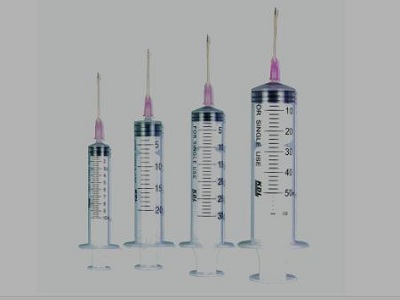Inspection Procedures for Disposable Syringes for Drug Dispensing
1. This inspection procedure is applicable to disposable syringes for dispensing.
Preparation of test solution
a. Take 3 dispensers randomly from the same batch of products (the sampling volume shall be determined according to the required inspection liquid volume and dispenser specification), add water to the sample to the nominal capacity and discharge it from the steam drum. Drain the water into a glass container at 37 ℃± 1 ℃ for 8h (or 1h) and cool it to room temperature as the extraction liquid.
b. Reserve a part of water of the same volume in a glass container as a blank control solution.
1.1 Extractable metal content
Put 25ml of extraction solution into 25ml Nessler colorimetric tube, take another 25ml Nessler colorimetric tube, add 25ml of lead standard solution, add 5ml of sodium hydroxide test solution to the above two colorimetric tubes, add 5 drops of sodium sulfide test solution respectively, and shake up. It shall not be deeper than the white background.
1.2 pH
Take solution a and solution b prepared above and measure their pH values with an acidimeter. The difference between the two shall be taken as the test result, and the difference shall not exceed 1.0.
1.3 Residual ethylene oxide
1.3.1 Solution preparation: see Appendix I
1.3.2 Preparation of test solution
The test solution shall be prepared immediately after sampling, otherwise the sample shall be sealed in a container for storage.
Cut the sample into pieces with a length of 5mm, weigh 2.0g and place it in a container, add 10ml of 0.1mol/L hydrochloric acid, and place it at room temperature for 1h.
1.3.3 Test steps

① Take 5 Nessler colorimetric tubes and accurately add 2ml of 0.1mol/L hydrochloric acid respectively, and then accurately add 0.5ml, 1.0ml, 1.5ml, 2.0ml, 2.5ml ethylene glycol standard solution. Take another Nessler colorimetric tube and accurately add 2ml of 0.1mol/L hydrochloric acid as the blank control.
② Add 0.4ml of 0.5% periodic acid solution into each of the above tubes respectively and place them for 1h. Then drop sodium thiosulfate solution until the yellow color just disappears. Then add 0.2ml of fuchsin sulfurous acid test solution respectively, dilute it to 10ml with distilled water, place it at room temperature for 1h, and measure the absorbance at 560nm wavelength with blank solution as reference. Draw absorbance volume standard curve.
③ Accurately transfer 2.0ml of the test solution into Nessler's colorimetric tube, and operate according to step ②, so as to check the corresponding volume of the test from the standard curve with the measured absorbance. Calculate the absolute ethylene oxide residue according to the following formula:
WEO=1.775V1 · c1
Where: WEO -- relative content of ethylene oxide in unit product, mg/kg;
V1 - corresponding volume of test solution found on the standard curve, ml;
C1 -- concentration of ethylene glycol standard solution, g/L;
The residual amount of ethylene oxide shall not be more than 10ug/g.
1.4 Easy oxides
1.4.1 Solution preparation: see Appendix I
1.4.2 Preparation of test solution
Take 20ml of the test solution obtained one hour after the preparation of extraction solution a, and take b as the blank control solution.
1.4.3 Test procedures
Take 10ml of extraction solution, add it into a 250ml iodine volumetric flask, add 1ml of dilute sulfuric acid (20%), accurately add 10ml of 0.002mol/L potassium permanganate solution, heat and boil for 3min, rapidly cool down, add 0.1g of potassium iodide, tightly plug, and shake well. Immediately titrate with sodium thiosulfate standard solution of the same concentration to light yellow, add 5 drops of starch indicator solution, and continue titrating with sodium thiosulfate standard solution to colorless.
Titrate the blank control solution with the same method.
1.4.4 Result calculation:
The content of reducing substances (easy oxides) is expressed by the amount of potassium permanganate solution consumed:
V=
Where: V -- volume of consumed potassium permanganate solution, ml;
Vs -- volume of sodium thiosulfate solution consumed by the test solution, ml;
V0 -- volume of sodium thiosulfate solution consumed by blank solution, ml;
Cs -- actual concentration of titrated sodium thiosulfate solution, mol/L;
C0 -- concentration of potassium permanganate solution specified in the standard, mol/L.
The difference in consumption of potassium permanganate solution between the infusion solution of the dispenser and the blank control solution of the same batch of the same volume shall be ≤ 0.5ml.
Post time: Sep-26-2022





